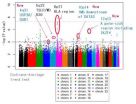(Press-News.org) In this month's edition of Physics World, Richard Taylor, director of the Materials Science Institute at the University of Oregon, takes a serious, objective look at a topic that critics might claim is beyond scientific understanding – crop circles.
As the global crop-circle phenomenon grows alongside advances in science and technology, Taylor notes how physics and the arts are coming together to produce more impressive and spectacular crop-circle patterns that still manage to maintain their mystery.
Today's crop-circle designs are more complex than ever, with some featuring up to 2000 different shapes. Mathematical analysis has revealed the use of constructions lines, invisible to the eye, that are used to design the patterns, although exactly how crop circles are created remains an open question.
According to Taylor, physics could potentially hold the answer, with crop-circle artists possibly using the Global Positioning System (GPS) as well as lasers and microwaves to create their patterns, dispensing with the rope, planks of wood and bar stools that have traditionally been used.
Microwaves, Taylor suggests, could be used to make crop stalks fall over and cool in a horizontal position – a technique that could explain the speed and efficiency of the artists and the incredible detail that some crop circles exhibit.
Indeed, one research team claims to be able to reproduce the intricate damage inflicted on crops using a handheld magnetron, readily available from microwave ovens, and a 12 V battery.
As Taylor writes, "Crop-circle artists are not going to give up their secrets easily. This summer, unknown artists will venture into the countryside close to your homes and carry out their craft, safe in the knowledge that they are continuing the legacy of the most science-oriented art movement in history."
Matin Durrani, Editor of Physics World, says, "It may seem odd for a physicist such as Taylor to be studying crop circles, but then he is merely trying to act like any good scientist – examining the evidence for the design and construction of crop circles without getting carried away by the side-show of UFOs, hoaxes and aliens."
Also in this month's issue:
End of an era – an interview with veteran CERN theorist John Ellis, who is back in the UK after almost four decades at the Geneva lab but still searching for the elusive Higgs boson.
Destination Moon – an interview with Ziyuan Ouyang, chief scientist of China's lunar programme.
###
Please mention Physics World as the source of these items and, if publishing online, please include a hyperlink to: http://www.physicsworld.com
Notes for editors:
1. Physics World is the international monthly magazine published by the Institute of Physics. For further information or details of its editorial programme, please contact the editor, Dr Matin Durrani, on tel +44 (0)117 930 1002. The magazine's website physicsworld.com is updated regularly and contains physics news, views and resources. Visit http://www.physicsworld.com.
2. For copies of Physics World and copies of the articles reviewed here contact Michael Bishop, IOP press assistant, tel +44 (0)117 930 1032, e-mail michael.bishop@iop.org.
3. The Institute of Physics is a leading scientific society promoting physics and bringing physicists together for the benefit of all.
It has a worldwide membership of around 40 000 comprising physicists from all sectors, as well as those with an interest in physics. It works to advance physics research, application and education; and engages with policymakers and the public to develop awareness and understanding of physics. Its publishing company, IOP Publishing, is a world leader in professional scientific communications. Go to www.iop.org.
END
Scientists on the Norwich Research Park, working with colleagues in China, have developed new techniques that will aid the application of genomics to breeding the improved varieties of crop needed to ensure food security in the future. By dissecting the complicated genome of oilseed rape they have been able to produce maps of the genome that are needed for predictive breeding.
Traditional breeding involves crossing two varieties and selecting the best performing among the progeny. Predictive breeding is a more advanced technique where specific parts of the genome most ...
New York, NY—July 31, 2011—Samuel K. Sia, assistant professor of biomedical engineering at Columbia Engineering, has developed an innovative strategy for an integrated microfluidic-based diagnostic device—in effect, a lab-on-a-chip—that can perform complex laboratory assays, and do so with such simplicity that these tests can be carried out in the most remote regions of the world. In a paper published in Nature Medicine online on July 31, Sia presents the first published field results on how microfluidics—the manipulation of small amounts of fluids—and nanoparticles can ...
Researchers at the RIKEN Center for Genomic Medicine (CGM), together with colleagues at Kyoto University, Tsukuba University, Harvard University, and other medical institutions have identified three new loci associated with susceptibility to adult asthma in the Japanese population. The findings appear in Nature Genetics and derive from a genome-wide study of 4836 Japanese individuals.
Around the world, hundreds of millions of people suffer from bronchial asthma, a chronic inflammatory disease characterized by symptoms of wheezing, shortness of breath and coughing. In ...
How do cells know where to position themselves and where to accumulate in order to carry out their functions correctly within each organ? Researchers with the Colorectal Cancer Lab at IRB Barcelona have revealed the molecular mechanisms responsible for organizing the intestinal epithelium into distinct comportments, defined by frontiers or territories. The study, headed by Eduard Batlle, coordinator of the Oncology Programme at IRB Barcelona and ICREA Research Professor, is published in today's online version of the Journal Nature Cell Biology, part of the prestigious editorial ...
Cold Spring Harbor, NY – A team of scientists at Cold Spring Harbor Laboratory (CSHL) has laid bare the mechanism behind a phenomenon called oncogene addiction in mice suffering from a form of leukemia that mimics acute myelogenous leukemia (AML) in humans. Significantly, the team was able to mobilize their newly gained understanding to target "addiction" pathways in the model mice, resulting in rapid and complete eradication of the cancer, which is usually fatal and resistant to conventional chemotherapy.
Oncogene addiction refers to the curious phenomenon that cancer ...
No-one likes a know-it-all but we expect to be able to catch them out: someone who acts like they know everything but doesn't can always be tripped up with a well-chosen question. Can't they? Not so. New research in quantum physics has shown that a quantum know-it-all could lack information about a subject as a whole, yet answer almost perfectly any question about the subject's parts. The work is published in Physical Review Letters.
"This is something conceptually very weird," says Stephanie Wehner of the Centre for Quantum Technologies at the National University of ...
Seventy per cent of eight-month-old babies have a salt (sodium chloride) intake higher than the recommended UK maximum level, due to being fed salty and processed foods like yeast extract, gravy, baked beans and tinned spaghetti.
Many are also given cows' milk, which has higher levels of salt than breast or formula milk, as their main drink despite recommendations that it should not be used in this way until babies are at least one year old. High levels of salt can damage developing kidneys, give children a taste for salty foods and establish poor eating practices that ...
Alexandria, VA — Tobacco related disease is a primary source of mortality for African American men. Recent studies suggest that "alternative" tobacco products may have supplanted cigarettes as the most common products used by young African Americans, according to new research published in the August 2011 issue of Otolaryngology – Head and Neck Surgery.
While the tobacco-related disease burden is higher in African American adults, prevalence rates of tobacco use among young African American teens are surprisingly lower than those reported for whites. This picture changes ...
Washington, D.C. – Colon cleansing - it's been described as a natural way to enhance well-being, but Georgetown University doctors say there's no evidence to back that claim. In fact, their review of scientific literature, published today in the August issue of The Journal of Family Practice, demonstrates that colon cleansing can cause side effects ranging from cramping to renal failure and death.
The procedure, sometimes called colonic irrigation or colonic hydrotherapy, often involves use of chemicals followed by flushing the colon with water through a tube inserted ...
In an effort to reduce the radiation dose delivered by computed tomography (CT) scans, staff at a community-based hospital developed a comprehensive CT radiation dose reduction program which has allowed them to reduce the radiation dose delivered by CT scans at their facility, according to an article in the August issue of the Journal of the American College of Radiology.
CT is an essential tool for the accurate diagnosis of disease and injury but is associated with radiation doses higher than those of conventional X-ray imaging. Although high doses of radiation are ...

